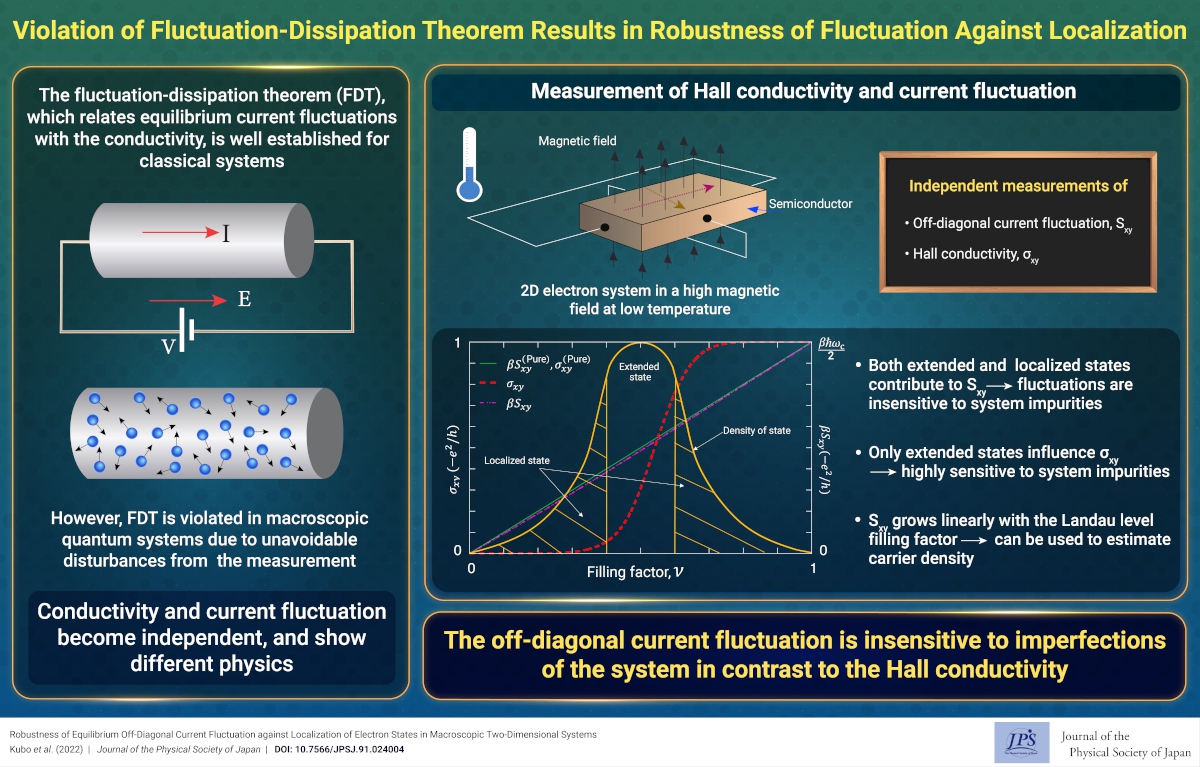Violation of Fluctuation-Dissipation Theorem Results in Robustness of Fluctuation Against Localization
© The Physical Society of Japan
This article is on
Robustness of Equilibrium Off-Diagonal Current Fluctuation against Localization of Electron States in Macroscopic Two-Dimensional Systems
(JPSJ Editors' Choice)
J. Phys. Soc. Jpn.
91,
024004
(2022)
.
We study equilibrium current fluctuations in systems without time-reversal symmetry, violating the fluctuation-dissipation theorem. Notably, the off-diagonal fluctuation is insensitive to system imperfections in contrast to other fluctuations and conductivity.

The fluctuation-dissipation theorem (FDT) claims that the current fluctuation in a macroscopic equilibrium system is equal to the product of the temperature and electrical conductivity. This “theorem” was proved for classical systems for all components of fluctuations including off-diagonal fluctuations, namely cross-time correlations between currents flowing in different directions.
However, the validity of the FDT in quantum systems was questioned, because disturbances by quantum measurement often play a crucial role, which was ignored in the proof of the FDT for classical systems. Recently, this long-standing question was formally solved, and the FDT was shown to be violated even when the fluctuation is measured in a way that simulates the classical ideal measurement as closely as possible. However, this formal solution neither gave concrete systems that exhibit the FDT violation nor estimated the magnitude of violation.
We propose a two-dimensional electron system in a magnetic field as a real physical system in which the FDT is violated. We clarify the conditions for large violations and show that the magnitude of violation is macroscopically large. In fact, the FDT for the off-diagonal component is significantly violated in a strong magnetic field at low temperatures, whereas the FDT for the diagonal component holds for any values of the parameters. In the standard setup used in the quantum Hall effect experiments, the off-diagonal current fluctuation is several tens of times larger than the product of temperature and Hall conductivity (off-diagonal conductivity).
Such a large violation implies novel properties of off-diagonal current fluctuations that are yet to be studied. Localized states of electrons contribute to the off-diagonal current fluctuation to the same extent as extended states, and hence, the off-diagonal fluctuation is insensitive to system imperfections. This is in sharp contrast to the Hall conductivity that is very sensitive to the imperfections because only extended states contribute. Moreover, as an application of this finding, we propose a new method for estimating the electron number density by measuring the off-diagonal fluctuation. Because fluctuations are a cause of error and noise, our results are expected to provide fundamental design guidelines for applications.
(Written by K. Kubo, K. Asano, and A. Shimizu)
Robustness of Equilibrium Off-Diagonal Current Fluctuation against Localization of Electron States in Macroscopic Two-Dimensional Systems
(JPSJ Editors' Choice)
J. Phys. Soc. Jpn.
91,
024004
(2022)
.
Share this topic
Fields
Related Articles
-
Qualitative Changes in Kinetic Pathways Driven by Hydrodynamic Interactions in Dense Colloidal Suspensions
Cross-disciplinary physics and related areas of science and technology
Statistical physics and thermodynamics
Structure and mechanical and thermal properties in condensed matter
2025-4-18
Even in dense colloidal suspensions, where long-range hydrodynamic interactions are screened, near-field hydrodynamic interactions qualitatively influence the selection of kinetic pathways.
-
Higher-Order Topological Phases in Magnetic Materials with Breathing Pyrochlore Structures
Electronic structure and electrical properties of surfaces and nanostructures
Magnetic properties in condensed matter
Mathematical methods, classical and quantum physics, relativity, gravitation, numerical simulation, computational modeling
2025-4-7
A simple example of a higher-order topological phase, in which the symmetry decreases step-by-step from the bulk to the corner, is realized in a magnetic system with a pyrochlore structure and is characterized by a series of quantized Berry phases defined for the bulk, surface, and edge.
-
Overcoming Phase Transitions for Faster Quantum Annealing
Statistical physics and thermodynamics
2025-3-27
This study presents an innovative method to address the problem of phase transitions in quantum annealing, resulting in an exponential speedup of the process.
-
Exploring the Vibrant Interplay of Machine Learning and Physics
Cross-disciplinary physics and related areas of science and technology
Electron states in condensed matter
Elementary particles, fields, and strings
Mathematical methods, classical and quantum physics, relativity, gravitation, numerical simulation, computational modeling
Statistical physics and thermodynamics
Superconductivity
2025-3-13
This Journal of the Physical Society of Japan Special Topics edition explores how physics and machine learning complement each other and can solve unresolved problems in physics.
-
A Unified Theory of Topological Hall Effect
Electronic transport in condensed matter
2025-3-6
This paper presents a unified theoretical description for the topological Hall effect, covering the entire region from strong- to weak-coupling, extending its picture beyond the Berry phase.




